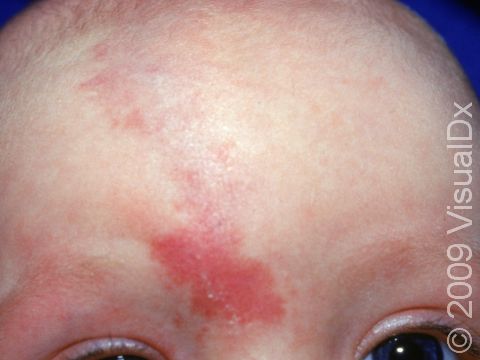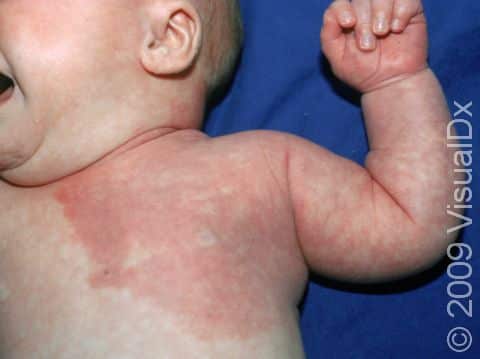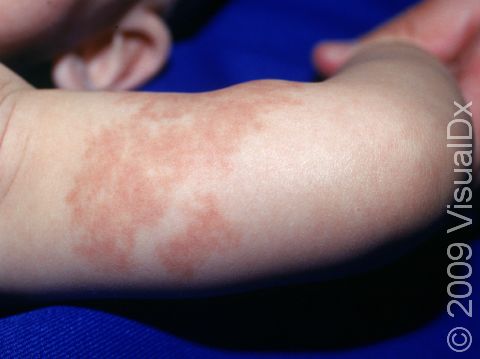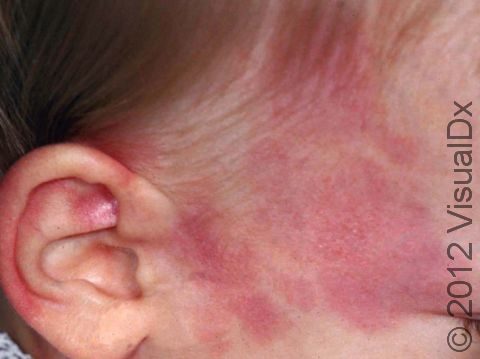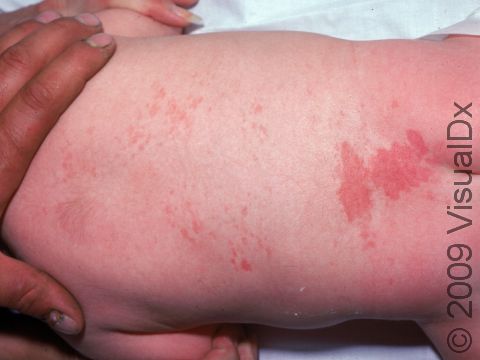Port-Wine Stain
A port-wine stain is a type of birthmark that is caused by a malformation of tiny blood vessels called capillaries. The name port-wine stain comes from the color of the birthmark, which ranges from light pink to a dark red color. Other small birthmarks that are related to port-wine stains are sometimes called salmon patches, which may also be called angel kisses (when they are on the baby’s face) and stork bites (when they are on the back of the baby’s neck). Like port-wine stains, salmon patches start as flat, pink or red patches; the difference between these birthmarks is that salmon patches tend to fade in the first year of life while port-wine stains become darker and grow along with the baby.
In the past, port-wine stains and salmon patches were considered to be variations of the same kind of birthmark, but now it is now known that port-wine stains are truly malformations of capillaries and will never improve on their own, while salmon patches are temporary dilatations (expansions) of capillaries that do typically improve on their own.
These birthmarks are noncancerous, but port-wine stains are sometimes associated with other syndromes involving the brain and development. Klippel-Trenaunay syndrome involves malformations of the veins (venous malformations), port-wine stains (capillary malformations), and excessive growth of the soft tissues. Additionally, some individuals with Klippel-Trenaunay syndrome have one limb that is longer and larger than the other limb. The syndrome is most frequently diagnosed in infancy or early childhood.
Who's At Risk?
Port-wine stains are always present at birth, though they may change in appearance as the baby gets older and grows. Approximately 1 in 1,000 babies is born with a port-wine stain. There is no known association within families (genetic tendency) at this time. Due to their similarity, it is important to note that salmon patches are much more common, and about 7 in 10 babies will have one of these.
Signs & Symptoms
Port-wine stains are never painful or itchy. It is sometimes difficult to tell the difference between a port-wine stain and other birthmarks, such as a salmon patch or a hemangioma, but it can be diagnosed by your child’s doctor, based on its appearance.
Self-Care Guidelines
There is no self-care required for a port-wine stain. Treat the skin as you would any other part of the baby, with careful, gentle cleansing and moisturization.
Treatments
Your child’s doctor will likely advise you to wait and see how the patch develops; if a port-wine stain is very large or on the baby’s face, however, he/she will likely recommend that your baby have further testing to make sure that there are no associated syndromes that might involve the brain or the baby’s development and will also recommend that you see a dermatologist in order to begin planning treatment. There is no treatment necessary for a port-wine stain, but some people are bothered by the appearance – particularly if it occurs on the face – and will choose to begin treatment earlier rather than later. The treatment usually involves laser therapy of the skin.
Visit Urgency
The skin of the port-wine stain should behave just like the skin on the rest of the baby, although the port-wine stain may darken and expand as the baby grows; if the skin bleeds or develops cracks or other problems, contact the child’s doctor for further advice.
Trusted Links
References
Habif TP. Clinical Dermatology: A Color Guide to Diagnosis and Therapy. 3rd ed. St. Louis, MO: Mosby; 1996:725-729.
Weston WL. Color Textbook of Pediatric Dermatology. 2nd ed. St. Louis, MO: Mosby Inc; 1996:213-218.
Wolff K, Goldsmith LA, Katz SI, Gilchrest BA, Paller AS, Leffell DJ, eds. Fitzpatrick’s Dermatology in General Medicine, 7th ed. New York, NY: McGraw-Hill; 2008:1652-1656.
Last modified on October 10th, 2022 at 7:50 pm

Not sure what to look for?
Try our new Rash and Skin Condition Finder
